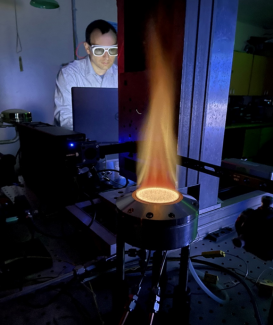Ammonia is used to clean our homes, workplaces, schools and hospitals; treat wastewater; fertilize our crops; make chemicals; and serve as a refrigerant for cooling systems. But it also has vast potential to be a carbon-free fuel for transportation and power generation if researchers can overcome a few key hurdles — hurdles that NETL is helping to clear thanks to some new laboratory capabilities.
For some time, scientists have known that using ammonia in combustion processes like internal combustion engines and gas turbines could help the world quickly transition to a carbon-free economy.
NETL’s Clint Bedick said ammonia can help solve many challenges related to America’s energy future without changing the nation’s existing infrastructure for distribution options if critical challenges can be overcome. Research capabilities like new additions to NETL’s Fundamental Combustion Laboratory at the Pittsburgh site are targeting those challenges as part of the Laboratory’s pursuit of the clean energy goals to attain economy-wide net-zero emissions by 2050.
According to a paper by Dogan Erdemir and Ibrahim Dincer in the International Journal of Energy Research, use of ammonia for energy has many attractive attributes: it is carbon free and environmentally benign; because it has three atoms of hydrogen, it may be used as a hydrogen carrier; its production, storage, transportation and distribution are much easier and less complicated than many other fuels; it can be a potential replacement for gasoline, diesel and kerosene; it can be considered for all combustion systems, ranging from engines to gas turbines; and it can be a potential fuel solution for clean power generation in remote areas.
But there are toxicity, flammability and emissions challenges that must be overcome before ammonia can be put to effective use in traditional engines, turbines and power generators.
That’s where some new capabilities at NETL come in.
Bedick explained that careful optimization of the combustion process is necessary, which is expected to differ considerably from approaches used in traditional fossil fuel combustion.
“A major barrier to developing these combustion strategies is a lack of high-quality fundamental validation data,” he said. “That’s precisely what the new capability at NETL will provide.”
Bedick said a new experimental capability has been added to the Fundamental Combustion Laboratory to enable the safe use of ammonia as a fuel source, in combination with other fuels such as hydrogen.
“We will be using a new lab-scale burner, which allows premixed flat flames to be generated,” he said. “These types of burners are used to study the underlying combustion characteristics in a highly controlled manner, where the fuel and the air are mixed prior to flowing through a porous burner surface and establishing a thin, flat flame a few millimeters downstream. In addition, new advanced diagnostics are being developed to allow high-quality model validation data to be generated.”
He added that these diagnostics represent a major part of the ammonia research effort. For example, NETL infrared absorption spectroscopy capabilities will be used to quantify chemical species composition and temperatures in various parts of the flame, including emissions such as nitrogen oxides.
NETL facilities will also be used to study flame speed, a fundamental property that defines the rate of expansion of the flame front in a combustion reaction.
The two biggest technical barriers to overcome are the low flammability of ammonia and high nitrogen oxide emissions that result because of the fuel-bound nitrogen.
In the case of flammability, mixing ammonia with traditional fuels or hydrogen can mitigate many of issues while reducing or eliminating carbon emissions. One approach being considered is the use of an upstream reformer to convert a portion of the ammonia to hydrogen, without requiring a secondary fuel source.
To reduce nitrogen oxide emissions, novel strategies such as two-stage rich-lean combustion are being studied through a combination of computational fluid dynamics modeling and experiments set to occur in NETL’s Fundamental Combustion Laboratory over the next few years.
The innovations will help NETL acquire fundamental validation data that will then allow researchers to make key adjustments and determinations for the efficient use of ammonia in engines and turbines for power generation.
NETL is a U.S. Department of Energy national laboratory that drives innovation and delivers technological solutions for an environmentally sustainable and prosperous energy future. By leveraging its world-class talent and research facilities, NETL is ensuring affordable, abundant and reliable energy that drives a robust economy and national security, while developing technologies to manage carbon across the full life cycle, enabling environmental sustainability for all Americans.
Top: Andy Tulgestke, an Oak Ridge Institute for Science and Education (ORISE) post-doctoral researcher at NETL works on diagnostic development for the ammonia combustion project in the Lab’s Fundamental Combustion Laboratory.




